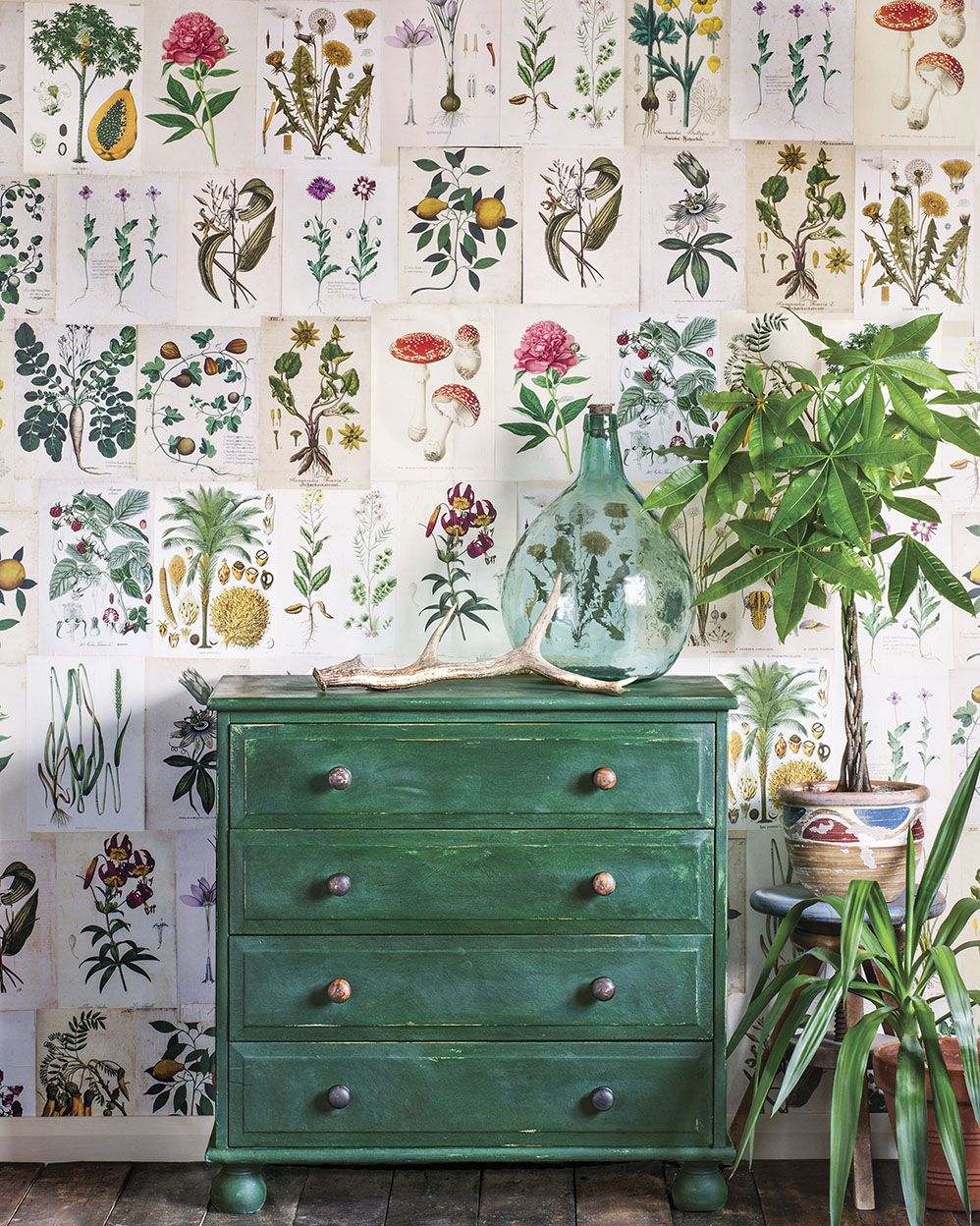
green chest in front of a wall decoupaged in botanical prints from a vintage book
When Flower‘s Jan/Feb 2021 issue began landing in our subscribers’ mailboxes, we received a question from a reader. “Could you please send me information about the wallpaper on page 33 (from the article about Annie Sloan)?” she wrote. The Flower editors love this decorative treatment too, but it’s not wallpaper. Annie created the look using pages from a book of botanical illustrations. Here, she shares how she accomplished this DIY project and also provides instructions for the chest, featuring her Amsterdam Green Chalk Paint.
DECOUPAGE WALL
I adore collecting old magazines and books, drawing inspiration from their illustrations, or even using them to decoupage onto furniture. For this look, I knew I wanted the focus to be on the color of Amsterdam Green, but I wanted to use these gorgeous old prints in the room, too. I decided to create a feature wall with these images from a vintage book on botanical drawings.
Individually using each page, I first laid out the images on the floor, positioning them until I knew more or less the pattern I wanted on the wall. Then, using my Decoupage Glue and a large brush, I painted the glue straight on to the wall and carefully glued each picture individually, making sure there were no air bubbles by gently pressing from the center of the image outwards. Once all the pictures were glued on to the wall, I painted a thin mixture of Decoupage Glue over the whole wall to seal any wayward corners.
AMSTERDAM GREEN CHEST OF DRAWERS
As for the chest of drawers, I knew I wanted to incorporate a deep, rich green so I chose my Amsterdam Green Chalk Paint, which is actually inspired by painted shutters and doors overlooking the canals of Amsterdam. The stylish, minimal color works well with neutral whites and creams and also suits earthier, soft tones such as Primer Red, Arles, and Old Ochre.

Follow the steps below to re-create this Annie Sloan DIY project.
STEP-BY-STEP
1 | For the chest of drawers I wanted to create a rustic, earthy, and slightly worn patina. I started by mixing my Chalk Paint colors Old White and Amsterdam Green to find the exact shade I wanted. Using my Pure Bristle Brush to add a little texture, I painted the chest of drawers with this mix. I knew I wanted to contrast the green with the natural wood, so I avoided painting the knobs.
2 | After allowing the lightened Amsterdam Green to dry, I painted the chest of drawers in Amsterdam Green not lightened and directly from the tin. To create textured paintwork, I used a Pure Bristle Brush, moving it in all different directions to create a slightly rough finish.
3 | Once the paint had dried, using my Small Wax Brush, I covered the whole piece in a coat of Clear Chalk Paint® Wax. I wax before sanding as this creates less dust when I wax, and also allows me to control exactly where I want to sand back to.
4 | When the wax was dry to the touch, I used my Sanding Pad in Medium (Coarse would have stripped the paint right back to the wood and Fine would be quite hard to work with as there were two layers of paint to take back). Medium was perfect as in some areas I could sand to the lightened Amsterdam Green and others I took it straight back to the original wood. Focusing on the areas that it would naturally sand and wear away meant that the final piece looks authentic and naturally aged.
5 | Finally, I worked another coat of Clear Chalk Paint® Wax on to the piece. This protects the paintwork, and also makes the piece water resistant.
I am thrilled with the final look. I really feel that it showcases the beautiful soft and earthy tones of Amsterdam Green and feels botanical in all the right ways.
Text and photography courtesy of Annie Sloan, anniesloan.com
Read next: Flower magazine’s Q&A with Annie Sloan, “Bold Strokes”





